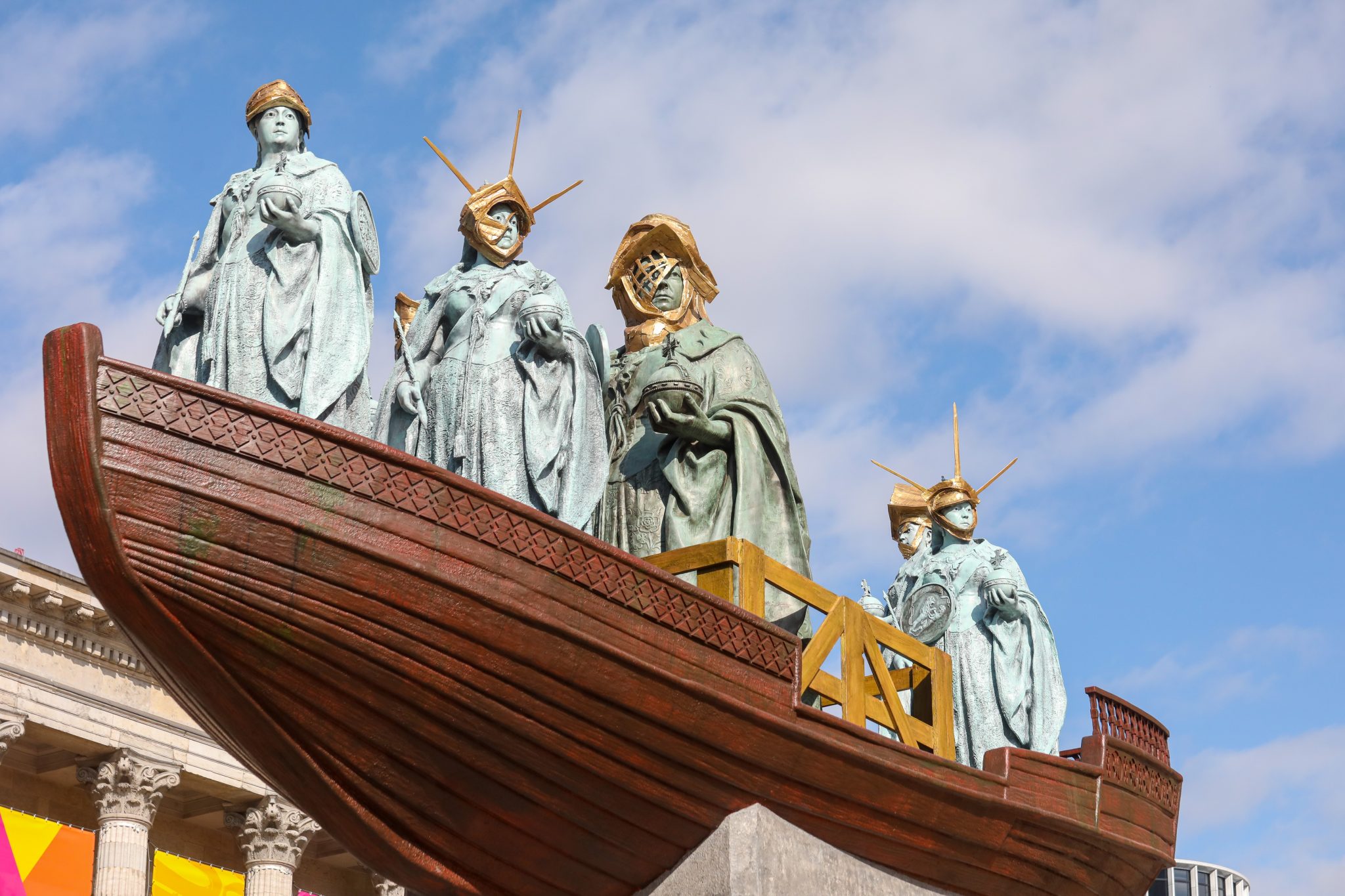In a discourse around public statues that typically consists of ‘keep’ vs ‘topple’, the artist’s Foreign Exchange shows a new path
During the 2021 Policy Exchange’s History Matters Conference, organised in the wake of the toppling of Bristol’s statue of slave trader William Colston and the wider wave of reckoning with public statues, former Secretary of State for DCMS Oliver Dowden equated the removal of statues with “a tendency to rewrite chunks of history”: a statement that entertains the nonsensical notion that monuments are neutral, and that history is fixed, and never rewritten. However, as Guyanese-British artist Hew Locke’s public sculpture Foreign Exchange demonstrates so deftly, history is not stagnant but an ever-evolving, dynamic thing, and Britain’s colonial-era monuments could do with some redressing.
Despite Locke’s long-standing interest in the power of historical statues, Foreign Exchange is his first public artwork, commissioned by Ikon Gallery to commemorate the Birmingham 2022 Commonwealth Games (the majority of the Commonwealth’s member states are former territories of the British Empire). Rather than creating an entirely new work, Locke has boldly reimagined a largely overlooked seven-metre-high monument to Queen Victoria which has stood in Birmingham’s Victoria Square since 1901 – the original marble statue replaced with a bronze replica in 1951. In doing so, Locke not only offers a revived, contemporary dialogue between past and present, but provides an alternative to the debate around public statues, which typically consists of ‘keep’ vs ‘topple’.
Victoria, who oversaw the expansion of the British Empire, stands within a crate added by the artist. Around it, and the rectangular plinth on which the whole sits, Locke has built a large boat, a recurring motif in his work. The boat here evokes foreign trade and exchange, the transatlantic slave trade and the subsequent indentured servitude, a system of bonded labour which saw over two million people transported from India to work in British colonies. On the boat’s deck, five smaller replica Victorias are positioned before and behind the original statue, 3D-printed in resin but appearing like patinated bronze. Together, they look as if about to be shipped off around the world, reminding us of how ubiquitous Victoria’s image was across the Empire. (Indeed, in some parts of the territories she governed she existed as no more than an image: she was, for example, granted the title of Empress of India in 1877, without ever having physically set foot on its soil.) Growing up in Guyana, Locke himself was no stranger to this ubiquity: at the work’s inauguration, the artist explained how he passed by a statue of Queen Victoria every day on his way to school; her head even adorned his exercise books. At a certain point such imagery is so ubiquitous one ceases to notice it. Foreign Exchange, by contrast, is so conspicuous that it cannot be ignored.

Locke has dressed the original Victoria with a Roman gladiator-helmet, her face partially covered by a visor, hinting at how historical figures are obscured and choreographed for political purposes. It is, for example, no coincidence that it was during the latter part of her reign that the British Empire was at its peak, and she is almost always represented as an older woman in public spaces. Each of the replicas meanwhile are wearing a martial helmet or mask of sorts, made in cardboard, cast in resin and painted gold. Golden spikes protrude from two helmets, like the rays of light on a halo adorning an Early Northern Renaissance Madonna, reminding the viewer of how society elevates powerful people to a saintly – and even godly – rank. They also recall the Statue of Liberty, a possible ode to New York’s Guyanese population – the fifth-largest foreign-born population in the city.
Foreign Exchange also discerningly points to the darker realities of Britain’s colonial history. Each Victoria carries an oversized medallion commemorating battles fought by the Empire, including the Battle of Seringapatam (1799), the Second Afghan War (1878–80) and the Capture of Trinidad from Spain (1797). By reviving the memory of these brutal conflicts in public space, Locke challenges the favoured representations of Empire that still dominate in film and TV.
During the History Matters conference, Dowden argued that “strong societies don’t try to airbrush their past, they don’t try to hide it away. They preserve and they cherish their heritage”. Locke – who does not advocate for the tearing down of statues – is holding Dowden to his word. With the utmost respect to the monument as a historical object, the artist’s embellishment richly enhances, and in doing so, presents multiple sides of Britain’s history, in all its messiness and complexity.
Foreign Exchange is quiet radicalism at its best. It does not pander to a particular point of view, or draw upon polarising opinions – nor does it impose ideology. Instead, it prompts the viewer to dig deeper – exactly what public art should do – and empowers people to ask questions around not only history, but the power and purpose of monuments. Locke’s playful commission deals with dark and painful histories with wit and grace, by casting what has always been, but carefully concealed, into plain view.
Foreign Exchange at Victoria Square, Birmingham, is presented by the Birmingham 2022 Festival, through 15 August
